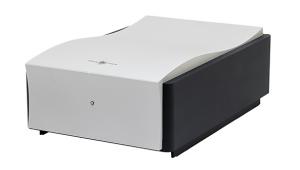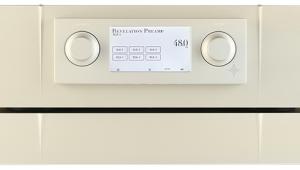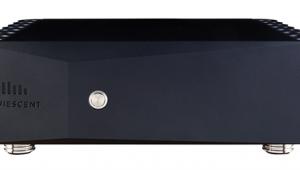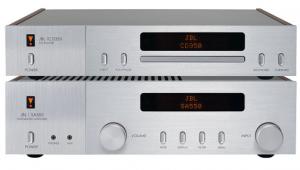Flying Mole Dad M310 (£600 Each)
Flying mole – now there’s an interesting name that would appear to fly against the face of convention. In this case, it’s the convention of Class A/B transistor amps and thermionic devices that glow in the dark. I am not even certain that they have moles in Japan. I’ve been to Tokyo a number of times and haven’t seen moles on the menu, so can only assume that they do not.
A quick look at the company’s website finds that its business philosophy is ‘to make things creative, simple and beautiful’. There is also a bit about harmony, nature and the environment. Well, it is a Japanese company.
SONIC SCREWDRIVER
These monoblocks have a number of useful features such as balanced input, and the option for a variable output via their unbalanced inputs. These connections are clearly explained in the owner’s manual, although I must admit to being a bit bemused by the setup for remote operation. If you have the partnering PAS 1 preamplifier (£1199) you can control the power amps via the preamp remote. You need to connect some wires to a small junction box on the back of each amplifier using a screwdriver, and whilst this is quite simple I do not believe it is that ‘creative’ or particularly ‘beautiful’ in this bluetooth wireless age.
Physically neat at just 214 x 91 x 450mm (whd) and relatively light at 4kg each, the overall impression is of a high build quality worthy of the price. Everything appears to fit together and the finish is first class right down to the feet and 4mm speaker connections.
STUDIO SHOUT
The one hundred and ten thousand Yen question is, how do they sound? Now I appreciate it’s a ‘digital’ amp but I was in an analogue mood, so I wired up my Audio Note M3 preamp, and let a needle hit the groove. JJ Cale sprung forth from my Snell Type C speakers, in a bright and frisky manner. Not in the way that affects the timing, by sounding fast, but just clear, clean and, well, detailed. It was time to sit back and let things warm up – having spoken to the importer, 12 hours should cover it. Bass was well controlled, not that extended, erring on the dry side but suitably powerful. The midrange and imaging overall had a sense of clarity that yelled ‘studio’, such was the amount of information and detail coming forth. That’ll be a gut slide guitar then with JJ sitting on a three-legged stool!
Now transported directly into the recording studio alongside Mr Cale, I heard front left, right and centre images well positioned and with good height. Depth was somewhat lacking so while there was some sense of room acoustic with individual instruments or vocals, the overall presentation was still slightly two-dimensional.
LISTEN BY LIMELIGHT
Now I must admit that I had a bit of a problem with this amplifier’s top-end quality, as though the upper-mid trombones and trumpets tended to take on an unnaturally pinched character. With too much lime on the old light, cymbals and hi-hats danced around the room like ricocheting bullets, such was the energy at the top of its spectrum.
To hand came Harry James and his big band on Sheffield Lab 3’s ‘Blues Stay Away From Me’. Again a crisp, clean and detailed sound emitted from the speakers, and in this case James’s trumpet raised some concern. The initial ‘pah’ that proceeds the trumpet notes was missing, and as the band played and James ‘ran some notes’, the recording took on a clinical quality, lacking the warmth and sense of occasion normally associated with brass and this particular recording.
Time to break out the violins to check out what was going on, with a Reference Recording, Vivaldi Concerto in E-flat RV 515, showing Vivaldi’s later style with its taste for elaborate figuration taken in the higher register at lightning speed. Here the violins managed to escape the brightness and coloration perceived on the earlier trumpets. In fact, the sound strangely lacked bite and attack, something I was not expecting. Everything remained clear and detailed, orderly and well-positioned but the initial transient had gone AWOL, as was found with Harry James’s trumpet, resulting in a lack of space and sense of acoustic. While the string tone was considered reasonable, there was a lack of body resonance from the violins, robbing the sense of occasion and elaboration associated with this recording.
MISPLACED WOODWIND
Using a Meridian 508 CD player, I fired up The Best of Schubert, Symphony No 8 in B minor ‘Unfinished’ [Naxos 8.556666]. The low-frequency introduction set the scene convincingly enough while the string section added nicely to the sense of tension, though I couldn’t be sure if that was a clarinet or oboe to the left of centre. The brass section took on the same character as before: quite sharp and lacking ‘pah’. Overall the sense of dynamics, tension and energy were well portrayed delivering a pleasing rendition – not wholly accurate, but enjoyable just the same.
With Puccini’s Madam Butterfly [Decca 417 577-2], trumpets took on their now-familiar presentation before Pavarotti stepped in, his vocals sounding somewhat ‘cuppy’, like his waistcoat was too tight and he needed to expand his rib cage. Dynamics and range were good with plenty of power driving the performance. The level of detail and clarity here was high enough to elevate the performance to an enjoyable level despite the earlier concerns over its vocal presentation.
VERDICT
Time to look at some scenarios and tick some boxes: in the best case the Flying Mole DAD-M310 amps have plenty of power, good bass, dynamics and detail. Despite their ‘studio’ sound quality they manage to convey the musical message and the artists’ performance. Worst case scenario is the upper mid colouration, lack of initial transient and ‘enthusiastic’ top end.
Originally published in the January 2008 issue
























































